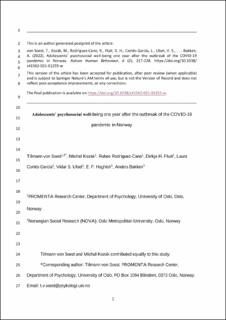| dc.contributor.author | von Soest, Tilmann | |
| dc.contributor.author | Kozák, Michal | |
| dc.contributor.author | Rodriguez Cano, Ruben | |
| dc.contributor.author | Fluit, Anne-Marie | |
| dc.contributor.author | Cortes Garcia, Laura | |
| dc.contributor.author | Ulset, Vidar Sandsaunet | |
| dc.contributor.author | Ebad Fardzadeh, Haghish | |
| dc.contributor.author | Bakken, Anders | |
| dc.date.accessioned | 2022-10-14T07:38:13Z | |
| dc.date.available | 2022-10-14T07:38:13Z | |
| dc.date.created | 2022-01-24T13:01:16Z | |
| dc.date.issued | 2022-01-20 | |
| dc.identifier.issn | 2397-3374 | |
| dc.identifier.uri | https://hdl.handle.net/11250/3026066 | |
| dc.description.abstract | The COVID-19 pandemic has dramatically restricted adolescents’ lives. We used nationwide Norwegian survey data from 2014–2021 (N = 227,258; ages 13–18) to examine psychosocial outcomes in adolescents before and during the pandemic. Multilevel models revealed higher depressive symptoms and less optimistic future life expectations during the pandemic, even when accounting for the measures’ time trends. Moreover, alcohol and cannabis use decreased, and screen time increased. However, effect sizes of all observed changes during the pandemic were small. Overall, conduct problems and satisfaction with social relationships remained stable. Girls, younger adolescents, and adolescents from low socioeconomic backgrounds showed more adverse changes during the pandemic. Estimated changes in psychosocial outcomes varied little with municipality infection rates and restrictions. These findings can inform means and interventions to reduce negative psychological outcomes associated with the pandemic and identify groups that need particular attention during and after the pandemic. | en_US |
| dc.description.sponsorship | This research was funded by three grants from the Research Council of Norway: Grant 666 no. 288083 (T.v.S. and V.S.U.), grant no. 300816 (T.v.S., M.K., R.R.C. and E.F.H.) and 667 301010 (T.v.S., M.K., D.H.F. and L.C.G.). | en_US |
| dc.language.iso | eng | en_US |
| dc.publisher | Nature Research | en_US |
| dc.relation.ispartofseries | Nature Human Behaviour;Volume 6, Issue 2 | |
| dc.subject | Epidemiology | en_US |
| dc.subject | Human behaviour | en_US |
| dc.subject | Viral infections | en_US |
| dc.title | Adolescents’ psychosocial well-being one year after the outbreak of the COVID-19 pandemic in Norway | en_US |
| dc.type | Peer reviewed | en_US |
| dc.type | Journal article | en_US |
| dc.description.version | acceptedVersion | en_US |
| cristin.ispublished | true | |
| cristin.fulltext | preprint | |
| cristin.fulltext | postprint | |
| cristin.qualitycode | 1 | |
| dc.identifier.doi | https://doi.org/10.1038/s41562-021-01255-w | |
| dc.identifier.cristin | 1988526 | |
| dc.source.journal | Nature Human Behaviour | en_US |
| dc.source.volume | 6 | en_US |
| dc.source.issue | 2 | en_US |
| dc.source.pagenumber | 40 | en_US |
| dc.relation.project | Norges forskningsråd: 288083 | en_US |
| dc.relation.project | Norges forskningsråd: 301010 | en_US |
| dc.relation.project | Norges forskningsråd: 300816 | en_US |
